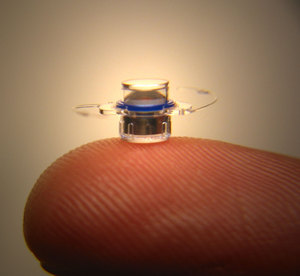DALLAS, TX--(Marketwired - Feb 11, 2015) - Here is a startling statistic to note during February's AMD/Low Vision Awareness Month: More Americans suffer from some form of macular degeneration (15 million) than from new cases each year of breast cancer, prostate cancer, plus Alzheimer's and Parkinson's disease combined (6.67 million).
This year, we can celebrate new hope for those afflicted with end-stage, age-related macular degeneration (AMD), as 500 people around the country have their sight back thanks to a tiny telescope implanted in their eye.
The device was recently approved by the FDA for those 65 and older, and the cost for the CentraSight telescope implant and visits associated with the treatment program are Medicare eligible. There are currently around 100 CentraSight provider teams offering the treatment throughout the U.S.
End-Stage Age-Related Macular Degeneration (AMD for short) has robbed nearly 1.8 million Americans, age 60 and older, of their sight, and more than 500,000 new cases are diagnosed each year. Until the availability of the CentraSight telescope implant, which was initially approved by the FDA in 2010, end-stage AMD patients had no other options.
The telescope implant is the only surgical option that improves visual acuity by reducing the impact of the central vision blind spot caused by end-stage AMD. Smaller than a pea, the telescope uses micro-optical technology to magnify images, which would normally be seen in one's "straight ahead," or central, vision. The images are projected onto the healthy portion of the retina not affected by the disease, making it possible for patients to see or discern the central vision object of interest.
Patients with end-stage AMD have a central blind spot. This vision loss makes it difficult or impossible to see faces, read, and perform everyday activities such as watching TV, preparing meals, and self-care. The telescope implant can improve patients' vision so they can see the things that are important to them, increase their independence, and re-engage in everyday activities. It also may help patients in social settings, as it may allow them to recognize faces and see the facial expressions of family and friends.
Eligible candidates for the treatment must be 65 years or older, and meet several other indications for treatment. Unfortunately, the telescope implant is not a cure for end-stage AMD. As with any medical intervention, potential risks and complications exist with the telescope implant. Possible side effects include decreased vision or vision impairing corneal swelling. The risks and benefits associated with the telescope implant are discussed in the Patient Information Booklet available at www.CentraSight.com.
Patients and physicians can find more information about the telescope implant and related treatment program at www.CentraSight.com or by calling 1-877-99SIGHT.
About CentraSight
CentraSight is the first-ever treatment program that utilizes a tiny telescope implant for end-stage age-related macular degeneration (AMD), the most advanced form of AMD and the leading cause of blindness in older Americans. Patients with end-stage AMD have a central blind spot in their vision that makes it difficult or impossible to see faces, read, and perform everyday activities. The CentraSight treatment program allows patients to see details again by implanting a tiny telescope in the eye in an outpatient procedure, then coordinating with vision specialists to help the patient learn how to use their new vision for everyday activities. For more information visit http://www.CentraSight.com/
Contact Information:
Jennifer Heinly
J&J Consulting
949-716-9829
